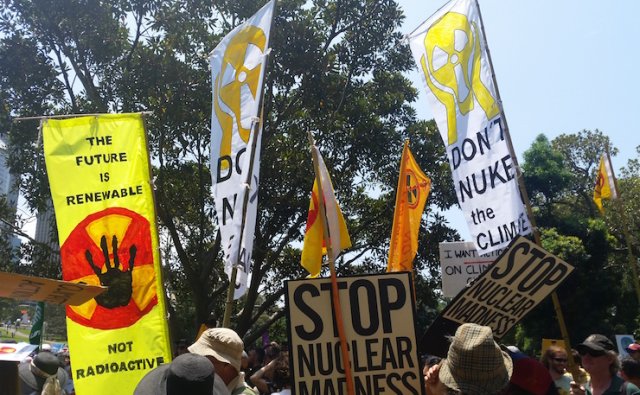
More than 2000 People's Climate Marches were held over the weekend of November 27 to 29. In Australia more than 140,000 people took to the streets to show they care, passionately, about climate change. They are also angry at government inaction, as illustrated by the many homemade placards and props.
These marches were the biggest national anti-government mobilisations for many years. The Melbourne march — a huge 60,000 people — was the biggest street march there since the anti-Work Choices protests of 2005.
Last year's March in March was comparable, with around 100,000 people taking to the streets against the Tony Abbott government. The previous most significant climate change rally was in November 2013, when GetUp! mobilised 60,000 people less than three months after the Abbott government's election.
Given the lack of such mass actions recently in the climate change movement, these numbers show that the major parties' climate inaction is generating a lot of anger and propelling people into action.
More aware
Australia is also experiencing temperature extremes, accompanied by bushfires, droughts and storms, which serve as constant reminders of climate scientists' warnings.
Most people believe the experts and find it hard to reconcile government inaction. More and more people now see the symbiotic relationship between the two major parties and fossil fuel corporations.
As the movements against unconventional gas — “fracking” — and coal have grown in strength, so too has a recognition that Aboriginal and Torres Strait Islander peoples must also have the right to refuse mining and exploration on their land.
We need more such rallies with clear, unifying demands. The People's Climate Marches called for 100% renewables, but did not articulate some of the obvious steps to get there — like cutting fossil fuel subsidies and leaving fossil fuels in the ground. This allowed a very small pro-nuclear contingent to join the Sydney march, posing nuclear as a legitimate alternative energy. All 10 were heckled.
By having two demands around fossil fuels, we would have amplified the Pacific island state of Kiribati's well-publicised demands. We would have connected with all the other low-lying communities facing the destruction of their lands.
We need to frame the discussion more around “How do we get there?” rather than just “What we want”.
What next?
The People's Climate March was fundamentally an alliance between large NGOs, such as GetUp!, the Australian Conservation Foundation (ACF), the Australian Youth Climate Coalition and AVAAZ. They have their political differences and limitations but collectively they put in welcome resources — money and personnel — to organise the marches in Melbourne, Brisbane and Sydney.
ACF, the main march organiser in Melbourne, has committed to mobilising with grassroots groups in the community following the march. But if this just means a narrow focus on marginal seat door-knocking, an opportunity to build a potent climate movement will be lost. Marginal seats campaigns tend to be marginal campaigns. Rather than shifting public opinion overall, they are more likely to deliver a couple of extra seats to Labor or the Greens while doing little to build a stronger movement.
In Melbourne, the organisers involved the grassroots network Victorian Climate Action Network (VCAN). But the “grassroots” we need to bring together is vast and diverse, including Aboriginal movements and campaigns, Lock the Gate, forest campaigners and others not represented by VCAN.
Grand coalitions, such as the People's Climate March organisers or Climate Action Network Australia, are not adequate for this. To build a stronger climate movement, we need initiatives from grassroots campaigns to build the campaigns and begin to link them together. Help from large NGOs is welcome to facilitate, but not direct, this process.
In Melbourne, a coalition of activists calling themselves Flood the System, is planning non-violent direct action to push the movement forward, from the end of the climate summit. It is important that this strand of the movement is welcomed and incorporated. We need to use tactics that bring attention to the issues and mobilise growing numbers of people from all walks of life.
Inclusivity and tokenism
Direct action stunts and resistance to specific developments are fantastic. Big peaceful protests are good too. Lobbying, electioneering and research also have their place. But ongoing mobilising, talking to and involving people are what will grow the movement.
In Sydney, the Redfern Aboriginal Tent Embassy and SOSBlakAustralia decided to boycott the rally after the People's Climate March organisers failed to undertake the necessary consultation.
They were also incensed, as were others, that the Nuclear for Climate Change group was marching. Given the federal government's plans to dump nuclear waste and mine uranium on traditional lands, which is also connected to forced community closures, the two groups felt salt was being rubbed into the wounds.
True solidarity, not tokenistic measures, is essential if we are to build an inclusive movement.
Inversely, despite many unions becoming official sponsors, their contingents were not very big in some cities. This is a problem — especially as the climate deniers are using scare tactics about jobs to dissuade people from rejecting the business-as-usual approach. With honourable exceptions, there is a lot of work needed to convince unions, especially those in the energy sector, to take on the climate change campaign beyond token endorsement.
On the eve of the opening of the COP21climate summit in Paris, Prime Minister Malcolm Turnbull refused to agree to a mild statement on phasing out “inefficient” public subsidies being given to the dirty fossil fuel industries — totalling $695 billion last year according to the International Energy Agency.
No surprises there. But it is a reminder that the climate justice movement has to become a lot more potent — and quickly — if it will have any hope of keeping warming below 1.5°C, as the Pacific Island communities are insisting.
Like the article? Subscribe to Green Left now! You can also like us on Facebook and follow us on Twitter.